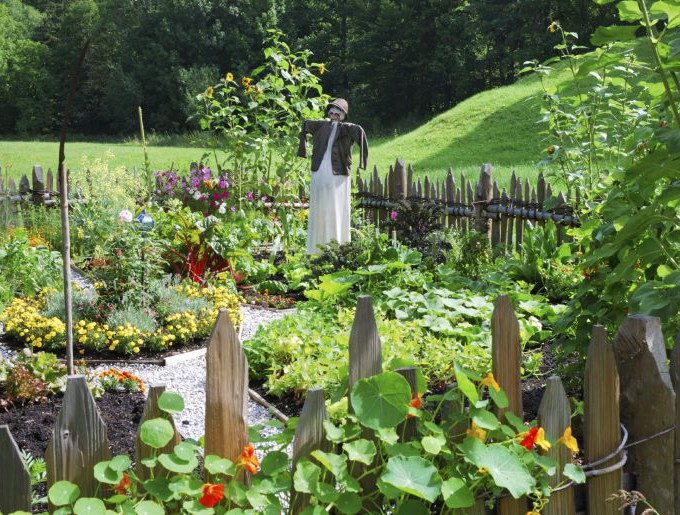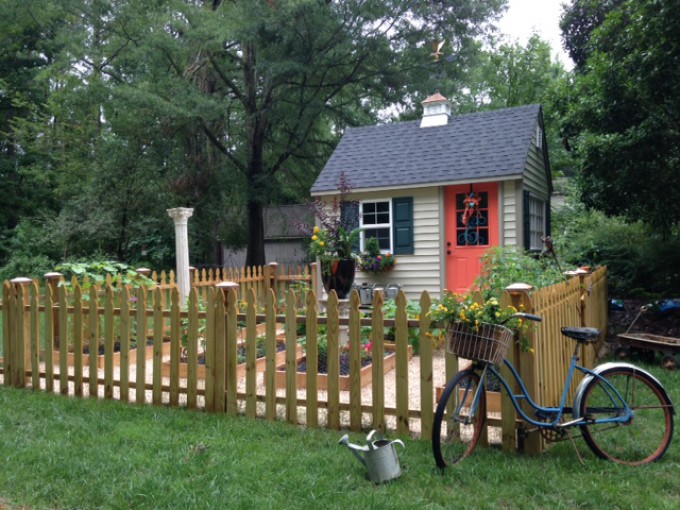The first warm days of late winter have arrived, the robins are here, the grass is greening, the days are longer, and many of us (like me) cannot wait to put our first vegetable seeds in the ground! Only now is it time to start those tomato & pepper seeds inside. But this year before you plant a thing, you might want to step outside and take a look at the bigger picture. How can I make my “edible garden” a thing of beauty?
Every spring, my Dad planted a big, square, freshly tilled plot with rows of lettuce, turnips, onions & potatoes. There were fruit trees in the garden and strawberries too. I loved Dad’s garden. But it was many years later when I could afford a house and land of my own, that I imagined creating a garden that was as beautiful as it was productive.
Not just a vegetable garden, but a Kitchen garden – a more intimate space, that would provide edible, visual and spiritual pleasures. It would have vegetables of course, but artfully planted in patterned beds with clean walkways inside a sheltered space with an inviting entrance. It would include herbs, flowers for fresh arrangements, dwarf fruit trees, ripe berries, and possibly a place to just sit with a glass of iced tea to give thanks for the abundance.
Here are a few photos for inspiration (click on the photos to expand), as well as
10 steps for designing your own Kitchen Garden.
1. Position tallest structures or plantings on the north site of the garden where they will not cast afternoon shade on smaller plans. Tall stuff would include your garden shed, dwarf fruit trees, blueberry bushes, asparagus bed, your tall bean trellises, okra, tomatoes & sunflowers.

Debbie Elston, created this entire garden, including the shed, last spring. In 3 months’ time she turned a boring lawn into a beautiful, productive garden with pops of bright orange, her personal signature color.
2. Raised beds heat up faster in spring, improve drainage and make it easier and less expensive to amend your soil. Borders make them more attractive and easier to maintain. Lumber, brick, cinderblock, stones or concrete, are all good choices, depending on your budget.

Inside her garden, Debbie used pedestals, trellis’, and a center urn on a pedestal to add vertical interest and style.
3. Size matters. If you are building a border for your beds, you may design them to be any height you desire. 8” to 10” wide lumber screwed into 4”x 4” corner posts will give you a good starting height. Design your beds to be no wider than 4’ to make it easier to reach the center from either side. Beds may be any length that fits your design.
4. Make paths around all sides of your vegetable beds, or keep beds narrow enough to reach across from only one side. You do not want to be compacting the rich loose soil inside your beds by walking on it. Make paths wide enough for your wheel barrows of compost or mulch.
5. Inexpensive paths can be of grass or wood chips. Depending on your budget, you may consider gravel, stone, brick or concrete paths in a style to compliment your home.

This Kitchen Garden uses rustic fencing, stone bed lines & a central focal point for a simple, elegant design. A border of herbs & perennials keeps it looking lush.
6. Border your garden with ornamental annuals and perennials. The blooms will bring more bees and other pollinators into your garden, give you a source of cut flowers, and keep it colorful all season.
7. Include culinary herbs. Butterfly larvae (caterpillars) love fennel, dill and parsley. Plant enough for them and for you! The tiny blooms of these herbs, plus mint, rosemary, oregano and others will attract loads of beneficial insects that help reduce the population of bad bugs. Once you have attracted the good guys to your garden, it is crucial to keep pesticides out and let your beneficial insects do the work.

My narrow garden space was perfect for a pattern of diamond shaped raised beds to grow flowers for fresh arrangements.
8. Think outside the box! Beds do not have to be square or rectangular. In fact, they are much more interesting when they are not. Consider a pattern of curved beds lines, diamond or L-shaped beds, circles (or any geometric combination) or paths between pie shaped beds, center islands of ornamental structures, pots or statuary – there is so much that can make your design unique. Let yourself dream a bit and sketch your ideas before heading out to dig. The addition of containers adds interest and will allow you to move your spring herbs like parsley & cilantro to a shady spot to keep them from bolting so quickly in the summer heat. You cannot miss the whimsical spiral design of this garden: Pollinator Garden, Columbus, OH
9. Make the most of your garden space by growing things vertically. Height also creates visual interest. Use tall trellises for pole beans, cucumbers and peas. Use the tallest tomato cages you can find as tomatoes can easily grow to 6-7’. (No matter what your “square foot” gardening guide tells you, plant tomatoes at least 2 1/2 feet apart.)

Edible Gardens can be as beautiful as they are productive.
10. Gates, walls, fencing, and arbors define your garden space and create a sense of enclosure for your garden room. Walls or fences can be used to espalier dwarf fruit trees. They can also deter furry creatures who love your veggies as much as you do. If rabbits are regular visitors, use rabbit wire mesh at the bottom of your fence and bury it 6”deep. Deer can hop a 4’ fence from a standstill. Only an 8’ fence will guarantee that they do not enter. However wide borders of deer-resistant shrubs, tall ornamental grasses or big leaf tropicals like canna lilies or castor bean plants are usually an effective deterrent. Raspberries make an excellent edible border, as deer do not like their prickly leaves & stems. Asparagus also makes a gorgeous 6’ tall border of perennial ferns that deer rarely eat.

Asparagus bed in summer.
With a little imagination and planning you can create a kitchen garden design attractive enough for your front yard. Fenced gardens are hard to expand later on, so leave enough room to grow all the things you love! (Be sure to visit the Paul J. Ciener Botanical Garden on Main Street in Kernersville, NC to see a beautiful kitchen garden designed by our local rock star garden designer, Chip Callaway.)
As with our homes and our fashion, gardens show off our personal style…
“Adornment is never anything except a reflection of the heart.” Coco Chanel
Happy Gardening!
Ellen









Thank you, Ellen, for encouraging us to do a little bit of what you do.
My gardens are my therapy.
Your gardens are my inspiration.
xoxo